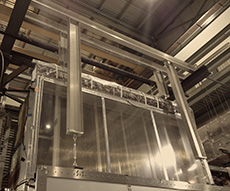SeaQuest sees first beam of 2013
 |
The SeaQuest experiment, run jointly by 15 institutions including Argonne Lab and Fermilab, saw beam last week for the first time in more than a year. While the beam was shut down during Fermilab's accelerator upgrade, experimenters and technicians made updates to the spectrometer, shown here. Photo: Sarah Witman |
Scientists from Fermilab, Argonne and 13 other international institutions on the SeaQuest experiment are in good spirits now that the experiment has seen beam for the first time in more than a year. Beam was delivered to SeaQuest on Friday, Nov. 8.
The experiment, based at Fermilab, studies the structure of protons and the behavior of the particles that compose them.
Protons contain a constantly simmering sea of particles called quarks and antiquarks, all bound together by the aptly named strong force, the strongest of the four fundamental interactions of nature. SeaQuest aims to shed light on the structure of protons, specifically, the ratio of up antiquarks to down antiquarks — two types of antiquarks with different properties. The experiment is also intended to study how the strong force binds particles and how those effects are modified when the proton is inside an atom’s nucleus rather than isolated and separated from the rest of the atom.
In the experiment, Fermilab's Main Injector sends a beam of protons into liquid hydrogen or deuterium or into solid carbon, iron and tungsten every minute. The burst of beam lasts 5 seconds.
The initial goal of SeaQuest is to confirm the results of the NuSea experiment, its predecessor, using lower-energy and higher-luminosity beam. NuSea results indicated that the ratio of down antiquarks to up antiquarks trends toward less than one, shaking up current assumptions about symmetry between these particles.
“We think in several months we will have enough data to confirm what NuSea saw,” said Paul Reimer, Argonne physicist and SeaQuest spokesperson. “Then we of course want to do better, which will take a year or more after that.”
The last time SeaQuest saw beam, it lasted about six weeks, from March 8 to the end of April 2012. The data from that run, Reimer says, was useful for debugging the detector and hammering out the algorithms they need to take data this time around.
During the roughly 17 months beam was turned off, researchers and technicians used the downtime to make technical improvements: replacing the vacuum beamline pipe and extraction septa, two critical pieces of equipment, and making several updates to the spectrometer, which collects data on the particles released in each interaction, allowing physicists to examine their behavior. They hope to achieve higher beam quality and smoother delivery of protons this time around, which should result in greater accuracy.
Reimer is pleased that the various postdocs and graduate students working on SeaQuest will now be able to complete their theses on the experiment.
“I’m really excited to get stuff out for them,” he said.
One such student is Josh Rubin, a postdoc from the University of Michigan. Rubin looks forward to exploring new possible uses for the now-updated spectrometer.
“We feel like, especially after this accelerator shutdown period, we have a really nice detector and experiment now,” Rubin said. “We are all excited at the chance to study the sea of quarks.”
—Sarah Witman
|